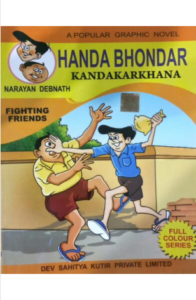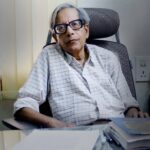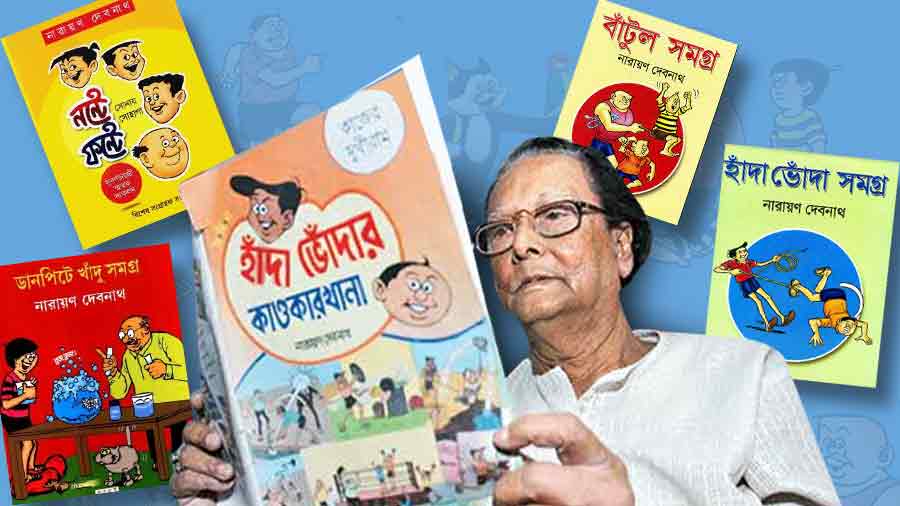Legendary Bengali comic book artist and writer Narayan Debnath bid adieu to a rich legacy on 18th January 2022 after prolonged ailment. He was 96. The story of his life and works traces the rise of comic book culture and the subtle art of sketching and storytelling that contributed immensely to Bengali literature.
Bengal is artistically plural with hues of literature, art, music and intellectual expressions. The ‘Para’ (Lane) culture led to the evolution of many a literary ‘Adda’ that shaped new imaginations and milestones of creativity.

One such lane of Shibpur, Howrah witnessed the birth of Bantul the Great created by Narayan Debnath with board brush strokes and black ink. Debnath ignited the imagination of young Bengali readers with a bald, barefoot hulk wearing a pink vest and a black half pant. That world lacked luster, glamour or any female character but brimmed with slapstick antics of hawai chappal wearing boys who enjoyed a hearty meal and harmless misadventures on scruffy lanes in small towns of Bengal.
Another lane of 3 lake Temple Road gave birth to Detective Paradosh Chandra Mitter alias Feluda by Satyajit Ray. Feluda accompanied his cousin and assistant -Topesh explored all shades of crime-thrill. Glimpses of these were first seen in the children’s magazine named ‘Sandesh’. The year was 1965.
It was in the same year that Bantul the Great first appeared in ‘Shuktara’ – another children’s magazine.
Illustrator and book cover designer Pronobesh Maity points out – “Debnath hails from East Bengal, and then settled at Howrah – Shibpur, where he was involved in body building in Friends club. Bantul was born somewhere in that gym in a satirical format.”Debnath’s subtle creation also includes iconic characters such as Handa-Bhonda. Next Debnath amazed us with this master creation of Nonte-Phonte – here these two boys were depicted trying to get through with their hostel life and evade or overcome tormentors in a comical format. His creation also includes Black Diamond Indrajit Roy, Patolchand The Magician, Detective Koushik Roy, Baahadur Beral, Daanpite Khandu Aar Tar Chemical Dadu, Petuk Master Batuklal, Sutki-Mutki, Hasir Atom Bomb. However, these later creations had not become popular.


Maity says, “It’s all about consistency. There are many other brilliant illustrators and cartoonists like Kafi Khan, Sailo Chakraborty, Sarbajit Sen and so on. Ain’t they drawing your attention? They too exist but it is Narayan Debnath’s consistent and lucid creations on Bantul, Handa Bhonda and Nonte Phonte that made him popular.”

These comic strips were created to delight young hearts with a fun filled humorous roller coaster ride. Debnath portrayed Bantul in a contemporary style.
In later editions, Debnath sent Bantul to war during the Indo-Pak war in 1971 (Bangladesh liberation war) spreading the smell of gunpowder in the air. Bantul was seen hurling tanks at the Pakistani army and ridiculing enemy firepower as bullets bounced off his 40 inch chest.
Debnath covered bloodshed in his comic episode for the first time inducing nationalistic sentiments in the minds of common people. Debnath also got Bantul involved in Kargil war’s Operation Vijay. The variety and topicality of his comic books and the involvement of his endearing creations in day to day situations as well as current affairs led young readers to wait for the next edition of his comic book with bated breath.

Script writer and guest lecturer Dhiman Dasgupta explains “Comic book is a pictorial language of disseminating ideas and thoughts. That can be humorous or serious. Mao Tse Tung’s Red book is one such ubiquitous symbol of 20th century radicalism to unleash China’s Cultural Revolution. During the Second World War too comics were used as propaganda against Hitler. Even to promote Jesus’ belief or introducing Einstein, Marxism or Post modernism. In India too, Ramayana and Mahabharata were introduced in pictorial form.”

Those were the times when on one hand Feluda’s victories in ‘Sandesh’ magazine, and on the other hand Bantul the Great trampled army troops on the cover pages of ‘Shukatara’ , kept children hooked to their comic books.
Later, master filmmaker Satyajit Ray breathed life into the comic creations from the silent pages of the book. After his passing away, Satyajit Ray’s son Sandip Ray carried forward the legacy and filled the vacuum. Feluda never faded from public memory.
Edited by Prem Shankar

